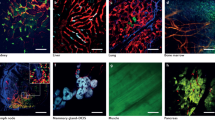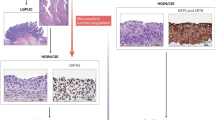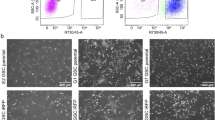Abstract
There has been no reliable orthotopic model available to visualize the growth of human superficial bladder cancer over time and to evaluate the efficacy of intravesical therapies. We have developed a novel approach to accomplish this task by generating human superficial bladder tumor cells to stably express high levels of green fluorescent protein (GFP) in vivo. Superficial bladder tumors were produced in athymic mice by intravesical instillation. In our initial studies tumors were quantitated by image analysis at a single time point, and the results compared to the estimation of the percentage of GFP cells present using flow cytometry after obtaining single cell suspensions of normal and tumor cells in the same bladder. A high correlation between the two methods was seen. Therefore, in subsequent studies, approximately 1 week after the intravesical instillation of the GFP expressing cancer cells a small incision was made to expose the bladder. The anterior, posterior, and lateral images of each bladder were captured to visualize GFP-expressing tumors. The ratio of green fluorescence pixel area, which represented the tumor burden, to the total area of the bladder was then calculated. A similar procedure was performed at 2, 3, and 4 weeks after instillation of the tumor cells. Using this procedure tumor progression over time could be measured in each mouse. By using this approach, it will now be possible to monitor the initial tumor sizes in the bladder of each mouse and then to evaluate the efficacy of various intravesical therapy protocols including intravesical gene therapy alone or in combination with other treatment modalities.
This is a preview of subscription content, access via your institution
Access options
Subscribe to this journal
Receive 12 print issues and online access
$259.00 per year
only $21.58 per issue
Buy this article
- Purchase on Springer Link
- Instant access to full article PDF
Prices may be subject to local taxes which are calculated during checkout







Similar content being viewed by others
References
Dalbagni G, Herr HW . Current use and questions concerning intravesical bladder cancer for superficial bladder cancer Urol Clin North Am 2000 27: 137–146
Watanabe T, Shinohara N, Sazawa A et al. An improved intravesical model using human bladder cancer cell lines to optimize gene and other therapies Cancer Gene Ther 2000 7: 1575–1580
Yamashita M, Rosser CJ, Zhou Z-H et al. Syn3 provides high levels of intravesical adenoviral-mediated gene transfer for gene therapy of genetically altered urothelium and superficial bladder cancer Cancer Gene Ther 2002 9: 687–691
de Martin R, Raidl M, Hofer E et al. Adenovirus mediated expression of green fluorescent protein Gene Ther 1997 4: 493–495
Chishima T, Miyagi Y, Wang X et al. Metastatic patterns of lung cancer visualized live and in process by green fluorescence protein expression Clin Exp Metastasis 1997 15: 547–552
Yang M, Hasegawa S, Jiang P et al. Widespread skeletal metastasis potential of human lung cancer revealed by green fluorescent protein expression Cancer Res 1998 58: 4217–4221
Naumov GN, Wilson SM, MacDonald IC et al. Cellular expression of green fluorescent protein, coupled with high-resolution in vivo videomicroscopy, to monitor steps in tumor metastasis J Cell Sci 1999 112: 1835–1842
Acknowledgements
This work was supported by a grant from the Retina Research Foundation and Tobacco Settlement Funds as appropriated by the Texas State Legislature. It was also supported by the Bladder SPORE Grant, the MD Anderson Core Grant CA16672 from the NCI and a grant from the American Foundation of Urological Disease.
Author information
Authors and Affiliations
Corresponding author
Rights and permissions
About this article
Cite this article
Zhou, JH., Rosser, C., Tanaka, M. et al. Visualizing superficial human bladder cancer cell growth in vivo by green fluorescent protein expression. Cancer Gene Ther 9, 681–686 (2002). https://doi.org/10.1038/sj.cgt.7700489
Received:
Published:
Issue Date:
DOI: https://doi.org/10.1038/sj.cgt.7700489
Keywords
This article is cited by
-
Effectiveness of two different dose administration regimens of an IL-15 superagonist complex (ALT-803) in an orthotopic bladder cancer mouse model
Journal of Translational Medicine (2019)
-
Cyclooxygenase 2-dependent and independent activation of Akt through casein kinase 2α contributes to human bladder cancer cell survival
BMC Urology (2011)
-
pcDNA3.1tdTomato Is Superior to pDsRed2-N1 for Optical Fluorescence Imaging in the F344/AY-27 Rat Model of Bladder Cancer
Molecular Imaging and Biology (2010)
-
Bladder cancer angiogenesis and metastasis—translation from murine model to clinical trial
Cancer and Metastasis Reviews (2007)
-
Efficacy of a single intravesical treatment with Ad-IFN/Syn 3 is dependent on dose and urine IFN concentration obtained: implications for clinical investigation
Cancer Gene Therapy (2006)



